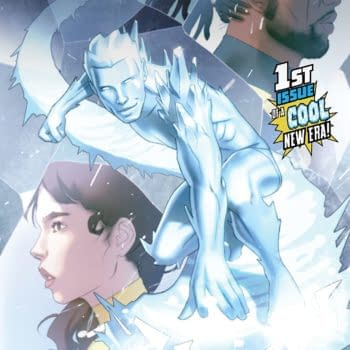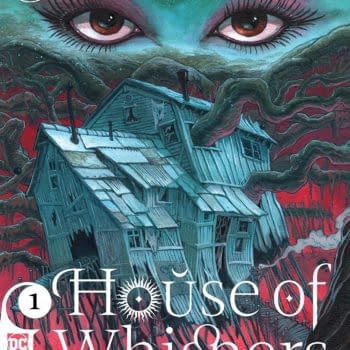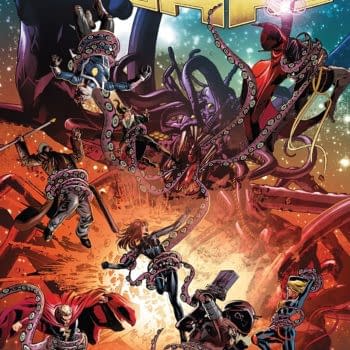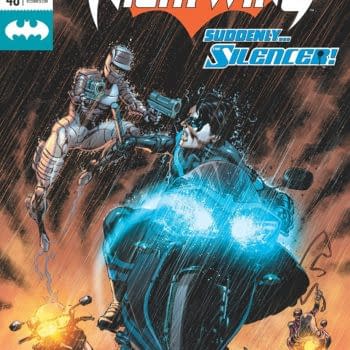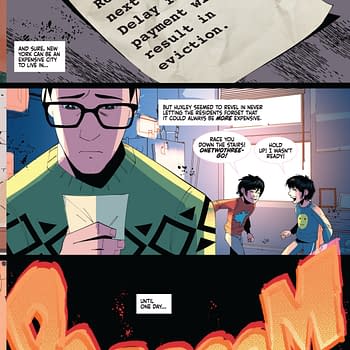Posted in: Comics | Tagged: Chad Lewis, HRL, king kong, Kong of Skull Island, kong: gods of skull island, Kong: Skull Island, phillip kennedy johnson
'Kong: Gods Of Skull Island' #1 Review: All Hail Mighty Kong
An expedition reaches Skull Island, looking for an uninhabited place to "civilize" and resources to mine and profit from. It's led by a man named James Copland, who discovered the island months earlier when his plane went down.
They find people who worship a god named Kong, and they run into trouble when they realize that they aren't grateful savages — but instead a thriving civilization which already had everything they needed for the life they lived.
Copland becomes more erratic. Much of the crew just wants to go home. However, Copland wants to carve out his legacy in Skull Island.

This comic delves into a lot of the questions that the film Kong: Skull Island did its best to dodge around in its focus on big action and fun.
Imperialism and race are themes that are interwoven throughout the earlier iterations of King Kong. The island-dwellers are savages forgotten by time and completely alien from the expedition. Kong himself is a metaphor standing in place of whatever minority you like (given the "'twas beauty that killed the beast" line and early 1900s obsession with black men chasing after white women, it is a more compatible stand-in for a black man).
To say that older iterations of King Kong are racist, Peter Jackson's three-hour beast included, isn't even a deep reading. It's on the surface and pretty obvious. Lindsay Ellis did a really good dive into the various incarnations of King Kong over the years and explains it better than I ever could.
That's why I was a little worried in starting Kong: Gods of Skull Island. It hit a lot of the beats as many other Kong incarnations. The imperialist aspect was a bit more front and center, but I was ready for Copland and the burly Hodge to be the well-meaning yet misled heroes and Mary to be the more mothering version of imperialist kindness that the "savages" of Skull Island deserve, with Hodge protecting her from the wilderness.
However, the comic does take a turn from this. In many ways, it does fall in line with Kong: Skull Island in that King Kong is the protector of the people whom share the island with him. However, instead of turning into Apocalypse Now with Samuel L. Jackson as Colonel Kurtz, it shows how the imperialist idea of sharing civilization was wrong all along,
That's not to say it avoids all the hang-ups of a story of this kind, but also gets some things right, which even more well-meaning critiques of the imperialist narrative often don't. For example, the natives of the Skull Island aren't naively innocent. They quickly learn what Copland's expedition is all about, and they simply use them for their resources and leave them out in the cold to die. That does paint the natives as a cruel, but it doesn't treat them simply as a prop with which to critique the white man. They're smart, and they know how to survive in this environment. They are smarter than the white people when it comes to Skull Island, and that's all that matters here.
Mary and Hodge are painted as more morally correct, but that doesn't really matter when things start falling apart for Copland's crew. Mary is still ignorant of the nature of Skull Island, and all of Hodge's weapons training and burliness don't amount to much in the face of massive bird creatures, killer reptiles, and a big frigging gorilla.
Copland is a great figure on which to hang the albatross of imperialism. He sees how it's been done, but he thinks he can get it "right." He only wants to "help" the natives, but he is more interested in his own legacy. He learns of their religion based around Kong, but he denies its existence, even when the evidence continues to pile up. He must have the correct vision of how the world works, and they can't be correct. It takes him seeing King Kong himself for his beliefs to change.

Character analysis and imperialist critique aside, the action in this comic does take a while to get going. However, when it starts, it amps up quickly. Kong gets to put the smack down on a variety of megafauna, and it's great. There is the necessary giant lizard and jaw-ripping scene.
This comic has a unique spin on it, and it's great. Artist Chad Lewis and color artist Dee Cunniffe put together a gorgeous Skull Island with bizarre and wonderful creatures and a menacing Kong. The natives also have armor made from wood and bones, which look great.
The comic is a bit of a slow burn, and it would be easy for some to struggle in getting through the setup. As such, the pacing isn't perfect, but it isn't awfully bad either.
There is also the young native named Kupak. He seems to be an example of how Skull Island isn't a place just anyone can inhabit, even someone who was born on the island. However, he does turn into a punching bag for all of Copland's cruelty. He doesn't get the opportunity to develop or be fleshed out beyond that.
The other problem is the eight-dollar price tag. That's a bit much to ask, even at roughly 40 pages of story. If that barrier is too much for you, then I cannot blame you.
However, for its few faults, Kong: Gods of Skull Island is an excellent take on the story of King Kong. Writer Phillip Kennedy Johnson put together an excellent story here. It has interesting characters and a fresh take on the source material. The art is great, and the action is exciting once it gets started. I highly recommend it, though the $7.99 price tag is still pretty rough.


